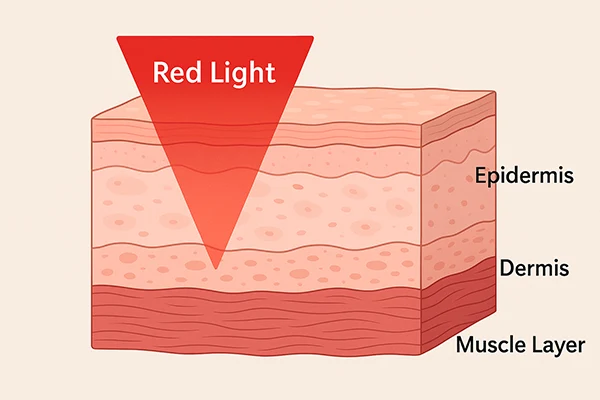O que os problemas de pele podem levar as máscaras faciais?
Summary:
LED face masks use different wavelengths of light—such as red, azul, and near-infrared—to help improve a variety of skin concerns, including acne, rosácea, hiperpigmentação, melasma, and sensitive skin. Each light penetrates the skin at different depths, activating cells, regulating metabolism, and promoting anti-inflammatory and repair functions. It is a gentle, non-invasive skincare method suitable for home use.
With the continuous advancement of skincare technology, LED face masks have gained widespread attention and popularity as a smart combination of science and beauty. Unlike traditional skincare methods that rely on topical ingredients, LED masks use specific wavelengths of light to penetrate the skin, stimulate cellular activity, and help improve overall skin condition. But how exactly do LED masks work, and which skin problems can they effectively target? Let’s break it down in detail.
Como as máscaras faciais LED funcionam?
Em termos simples, LED therapy devices utilize different wavelengths of light to interact with the skin. These lights are absorbed by certain pigments in the skin—also known as chromophores—triggering either photothermal ou photochemical reactions. These reactions can boost cellular metabolism, melhorar a circulação sanguínea, activate fibroblasts, and stimulate collagen production, all of which contribute to healthier, more radiant skin.

Então, why does light affect the skin at all? It’s because skin cells contain chromophores like melanin, hemoglobin, and cytochrome c in the mitochondria. When these absorb specific wavelengths of light, they convert that light into energy or initiate biochemical reactions within the cells.
Por exemplo, IPL (Intense Pulsed Light) devices used for hair removal emit light in the 640–1200 nm range, which penetrates the dermis. The melanin in hair follicles absorbs this energy and converts it to heat, effectively destroying the follicle—a process known as photothermal reaction.
Dispositivos LED, por outro lado, use lower-energy light in specific wavelengths like red (around 630 nm) or blue (around 415 nm), which generate photochemical reactions. These reactions help with inflammation reduction, reparo da pele, brightening, e antienvelhecimento.

Which Skin Concerns Can LED Face Masks Help Improve?
LED face masks are non-invasive light therapy devices that emit specific wavelengths of light to target skin issues at the cellular level. Here’s how they help address some of the most common skin problems:
1. Acne (Pimples, Blackheads)
Luz azul (410–470 nm) is commonly used in LED masks and is highly effective in treating acne.
Blue light can reach the outer layer of the skin and target Propionibacterium acnes, the bacteria responsible for breakouts. It activates a compound in the bacteria called porphyrin, which then produces reactive oxygen species (ROS) that kill the bacteria.
Blue light also helps regulate sebaceous (óleo) gland activity, reducing clogged pores and preventing new breakouts. When used alongside red light, it can also reduce inflammation, speed up healing, and fade acne scars more quickly.

2. Rosacea (Vermelhidão, Inflammation, Pele Sensível)
Rosacea is a chronic inflammatory skin condition that presents as redness, visible blood vessels, and sometimes small bumps.
Luz vermelha (630–650 nm) e near-infrared light (830 nm e acima) are both effective for soothing and calming rosacea-prone skin.
Red light penetrates into the dermis to boost cellular metabolism and improve microcirculation, helping reduce redness and strengthen capillaries. Near-infrared light reaches deeper layers and can promote muscle repair and skin resilience, reducing the chance of recurrent inflammation.
Although LED therapy can’t cure rosacea, it offers an effective complementary treatment for reducing flare-ups and improving overall skin comfort.
3. Hyperpigmentation (Dark Spots, Post-Acne Marks, Sun Spots)
Hyperpigmentation is often caused by UV exposure or inflammation, such as leftover marks from acne.
Red and near-infrared light help speed up skin cell turnover and stimulate collagen production, promoting quicker fading of pigmentation.
LED therapy also improves the skin’s metabolic rhythm, encouraging melanin breakdown and expulsion. Over time, this leads to a more even skin tone and a reduction in visible dark spots or acne scars.
4. Melasma
Melasma is a complex pigmentation issue influenced by sun exposure, hormones, e inflamação.
A combination of red and yellow light in LED masks can gently improve microcirculation, reduce pigmentation, and strengthen the skin barrier.
While LED light cannot shatter pigment the way IPL or lasers can, it offers a gentle and safe alternative for long-term maintenance and regulation of melasma-prone skin.
5. Pele Sensível
Sensitive skin is usually linked to a weakened skin barrier, leading to redness, tightness, coceira, or stinging sensations.
Red light has anti-inflammatory, reparative, and soothing properties, making it ideal for calming irritated skin and restoring barrier function.
For reactive or post-procedure skin (like after microneedling or peels), red light accelerates healing. Meanwhile, low-intensity near-infrared light stimulates the regeneration of myofibroblasts, helping to build deeper skin resistance and protect against future irritation.
Conclusão
Resumindo, LED face masks are a safe and gentle skincare solution that uses targeted light therapy to address a variety of skin concerns. Whether you’re dealing with breakouts, discoloration, sensitivity, or early signs of aging, LED light therapy offers a non-invasive way to support your skin’s natural repair processes.
That said, LED therapy isn’t a miracle fix—it works best as a consistent, supportive treatment, ideally paired with good skincare habits and sun protection. With regular use, LED face masks can help you reveal clearer, healthier, and more resilient skin over time.

